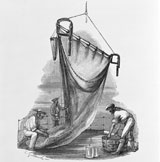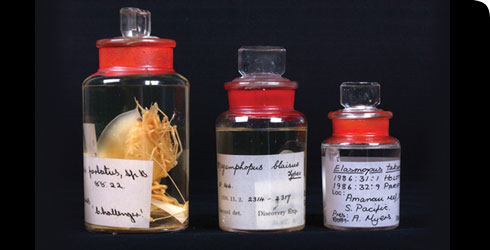Studying the deep ocean
In February 1873, the crew of HMS Challenger began taking samples at a depth of 3.5km, 64km south of the Canary Islands.
When the ship returned to England, over 3 years later, it had sailed over 68,890 nautical miles, criss-crossed all the major oceans apart from the Indian Ocean, and visited 362 sampling stations.
Sampling methods

An illustration of the crew of Challenger using a trawl net to find specimens from the sea bed
At each sampling station, scientists measured the depth of the water and the temperature at the surface, near the bottom, and at points in between.
Several types of sample were taken. The crew took sediments from the ocean floor and water samples to be chemically analysed later. They also trawled or dredged the sea bed to collect biological samples, and plankton nets were often used to collect midwater animals down to about 1.5km. Each time, the catch had to be carefully sorted, preserved, bottled, labelled, stored and documented.
Challenger’s crew regularly recorded the speed and direction of the surface currents and tried to measure the shallow subsurface currents too, although this was done less regularly.
Old techniques
One of the strengths of the expedition was that almost all the sampling techniques had been tried and tested on other ships – they weren’t completely new. The crew of Challenger were able to improve on some of them. For example, the thermometers on board HMS Challenger were modified and made more accurate than they had been on previous small-scale expeditions around Britain's coast.
The Challenger voyage was also set apart from previous voyages by the detailed observations, global coverage and emphasis on sampling in very deep water, as well as the hard work and dedication of those involved.
Deep water sampling
The deepest samples of all were taken at 8.2km deep, in the south-western Pacific. This is now called the Challenger Deep and it is near the lowest recorded point on Earth, over 11km deep in the ocean.
Challenger dredged 25 times in depths below 4,500m and the deepest was at 5,700m – far deeper than ever before.
Toolbox

Our fossil insect collection includes Rhyniognatha hirsti, the world's oldest fossil insect, dating back some 400 million years.
